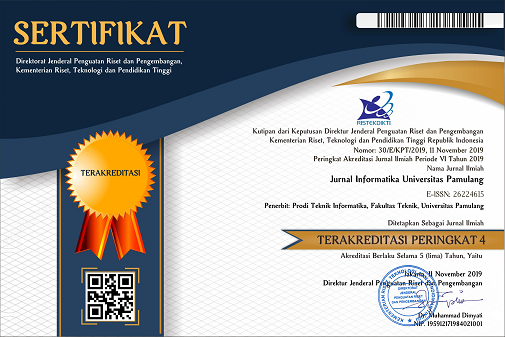Implementasi Metode K-Means Clustering pada Sistem Rekomendasi Dosen Tetap Berdasarkan Penilaian Dosen
DOI:
https://doi.org/10.32493/informatika.v3i4.2133Keywords:
k-means clustering, lecturer, assessment, recommendation, universityAbstract
Qualified lecturers can be one of the recommendations for lecturers to become permanent lecturers. The requirement to become a lecturer is to be able to teach, educate, and broaden the horizons of the students he teaches. One way to get qualified lecturers is to evaluate the performance of lecturers at the end of each semester, to find out whether the lecturer has a good performance or not. The use of the K-means clustering method as a system aide in determining lecturer recommendations will greatly assist the university in appointing lecturers as permanent lecturers. The way to work on the K-means clustering method is to find the centroid value in the value of each lecturer and in the process of getting a permanent lecturer candidate. In the results of the calculation of the K-means clustering method for 70 lecturers' assessment data in the system, which included a decent category there were 39 data. In this case, the success rate of the K-means clustering method was obtained at 55.71% success rate.References
Hendini, A. (2016). Pemodelan UML Sistem Informasi Monitoring Penjualan Dan Stok Barang (Studi Kasus : Distro Zhezha Pontianak). Jurnal Khatulistiwa Informatika, vol. IV, no. 2, pp. 107-1016.
J. O. Ong, "Implementasi Algoritma K-means Clustering Untuk Menentukan Strategi Marketing President University," Jurnal Ilmiah Teknik Industri, vol. 12, no. 1, pp. 10-20, 2013.
M. Rosmiati, "Analisis dan Perancangan E-Service Untuk Pelanggan Pada Jaya Bersama Konveksi," Indonesian Journal on Software Engineering, vol. 1, no. 1, pp. 1-7, 2015.
Muslihudin, M., Triananingsih, F., Kasmi, & Anggraei, L. (2017). Pembuatan Model Penilaian Indeks Kinerja Dosen Menggunakan Metode Fuzzy Simple Additive Weighting. Seminar Nasional Teknologi Informasi dan Multimedia, 5(1), 25-30.
Muzakir, A. (2014). Analisa Dan Pemnafaatan Algoritma K-Means Clustering Pada Data Nilai Siswa Sebagai Penentuan Penerimaan Beasiswa. Prosiding Seminar Nasional Aplikasi Sains & Teknologi , 195-200.
Nagesh, A. S., & Satyamurty, C. V. (2018). Aplication of Clustering Algorithm for Analysis of Student Academic Performance. Internasional Journal of Computer Science and Egineering, 6(1), 381-384.
Nasari, F., & Darma, S. (2015). Penerapan K-Means Clustering Pada Data Penerimaan Mahasiswa Baru. Seminar Nasional Teknologi Informasi dan Multimedia, 73-78.
Parlina, I., Windarto, A. P., Wanto, A., & Lubis, M. R. (2018). Memanfaatkan Algoritma K-Means Dalam Menentukan Pegawai Yang Layak Mengikuti Asessment Center Untuk Clustering Program SDP. Journal of Computer Engineering System and Science, 3(1), 87-93.
Purnamasari , I., & Afnisari, K. (2018). Performasi Klasifikasi Dosen Berprestasi Menggunakan Metode Naive Bayes Classifier. Jurnal Komputer dan Informatika Akademi Bina Sarana Informatika, XX(2), 45-50.
Raval, U. R., & Jani, C. (2016). Implementasi & Improvisation of K-Means Clustering Algorithm. Internasional Journal of Computer Science and Mobile Computing, 55(5), 191-203.
Santoso and R. Nurimalina, "Perencanaan dan Pengembangan Aplikasi Absensi Mahasiswa Menggunakan Smart Card Guna Pengembangan Kampus Cerdas (Studi Kasus Politeknik Negeri Tanah Laut)," Jurnal Integrasi, vol. 9, no. 1, pp. 84-91, 2017.
Wahyuningtyas, E. U., Putri, R. M., & Sutrisno. (2018). Optimasi K-Means Untuk Clustering Dosen Berdasarkan Kinerja Akademik Menggunakan Algoritma Genetika Paralel. Jurnal Pengembangan Teknologi Informasi dan Ilmu Komputer, 2(8), 2628-2635.
Downloads
Published
Issue
Section
License
Authors who publish with this journal agree to the following terms:
- Authors retain copyright and grant the journal right of first publication with the work simultaneously licensed under a Creative Commons Attribution-NonCommercial 4.0 International (CC BY-NC 4.0) that allows others to share the work with an acknowledgement of the work's authorship and initial publication in this journal.
- Authors are able to enter into separate, additional contractual arrangements for the non-exclusive distribution of the journal's published version of the work (e.g., post it to an institutional repository or publish it in a book), with an acknowledgement of its initial publication in this journal.
- Authors are permitted and encouraged to post their work online (e.g., in institutional repositories or on their website) prior to and during the submission process, as it can lead to productive exchanges, as well as earlier and greater citation of published work (See The Effect of Open Access).
Jurnal Informatika Universitas Pamulang have CC-BY-NC or an equivalent license as the optimal license for the publication, distribution, use, and reuse of scholarly work.
In developing strategy and setting priorities, Jurnal Informatika Universitas Pamulang recognize that free access is better than priced access, libre access is better than free access, and libre under CC-BY-NC or the equivalent is better than libre under more restrictive open licenses. We should achieve what we can when we can. We should not delay achieving free in order to achieve libre, and we should not stop with free when we can achieve libre.
Jurnal Informatika Universitas Pamulang is licensed under a Creative Commons Attribution-NonCommercial 4.0 International (CC BY-NC 4.0)
YOU ARE FREE TO:
- Share : copy and redistribute the material in any medium or format
- Adapt : remix, transform, and build upon the material for any purpose, even commercially.
- The licensor cannot revoke these freedoms as long as you follow the license terms





